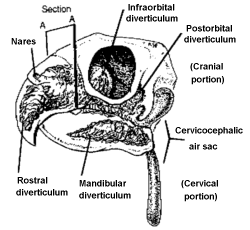When a distressed bird is taken to an avian veterinarian, respiratory disease is often found to be the cause. Frequent sneezing, nasal discharge, periocular swelling, coughing, wheezing, and a voice change may be evident. Dyspnea, or labored breathing, may be seen at rest or after the bird flies a short distance. “Tail bobbing” or a rhythmic jerking movement of the tail may also be observed.
Poor nutrition is a major factor in the development of respiratory tract disease. Vitamin A is essential for the health and integrity of the epithelial lining of the respiratory tract. Hypovitaminosis A, a deficiency in vitamin A, leads to changes in the respiratory epithelium which allow bacteria, virus, and fungi to invade the body. Poor nutrition also affects the immune system, further weakening the normal protective defense mechanisms of the avian repiratory tract.
Respiratory signs are not always the result of disease of the respiratory tract. Other disorders may mimic respiratory tract disease. Birds don’t have a diaphragm that separates their thoracic cavity from their abdominal cavity. As a result, abdominal fluid or ascites, an enlarged liver, or abdominal tumors may cause labored breathing.
Last month’s article covered the anatomy of The Avian Respiratory System. This month’s article addresses some of the avian respiratory disorders. Additional ones will be discussed in next month’s article.
Common Disorders of the Respiratory Tract
Hypovitaminosis A
As mentioned earlier, Vitamin A deficiency often plays a role in respiratory problems in birds. This deficiency is common in birds on an all seed diet. Blunting of the small projections or papilla around the opening in the roof of the mouth are frequently seen as well as granulomas (small walled off abcesses) in the oral cavity. Treatment involves improving the diet (switching from seeds to pellets) adding fruits and vegetables and injectible and oral viatmin A supplementation.
Rhinitis
Rhinitis is an inflammation of the nostrils. Any persistent nasal discharge is abnormal. It can be clear and thin or yellow and mucoid. Nasal discharge is an indication of rhinitis which may be caused by bacteria, viruses, fungal organisms or foregn bodies. Dust and powder from other bird’s feathers – especially cockatoos, greys and cockatiels, can cause rhinitis. Low humidity in conjunction with the aforementioned airborne respiratory irritants can lead to rhinitis. This is especially prevelant in birds from moist tropical climates such as macaws and amazons. The nasal exudate may become hard and plug-like, obstructing the nostril. As this concretion enlarges, the nostril becomes grossly distorted.
Rhinoliths, or plugs formed by hardened mucus, may be softened and removed. The nasal area may be cultured to determine the cause and flushed to clear the nasal openings. Underlying factors such as poor diet, dust, and infection are identified and corrected.
 Air sacculitis
Air sacculitis
Air sacculitis is an infection of the air sacs. Chronic air sacculitis is common in birds. Poor blood supply to the airsacs makes removal of inhaled microorganisms very difficult by the bird’s immune system. Signs of air sacculitis may be present at rest or only after flying. Coughing, wheezing, and labored repiration may be observed. Diagnosis is made by listening with a stethascope, xrays and endoscopy (looking inside a body cavity with a fiber optic instrument). Cytology (sampling of cells) and cultures may be necessary to identify the inciting bacteria, virus or fungus.
Periorbital Swelling
Periorbital swelling or swelling around the eye, is most commonly caused by sinusitis and vitamin A deficiency. The infraorbital sinus is a large sinus that surrounds the eye and extends into the upper and lower beak. This sinus opens upwards into the nasal cavity and therefore any infection of the infraorbital sinus cannot drain easily. Sinusitis may be caused by bacteria, fungal or chlamydial organisms. Cultures and sampling of cells are often necessary to establish the causative organism. Drainage, systemic medication and flushes are often a necessary part of the treatment. If vitamin A deficiency is suspected, viatmin A is administered as well as the necessary dietery changes.


 Air sacculitis
Air sacculitis